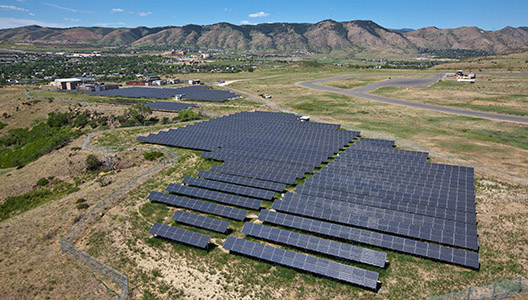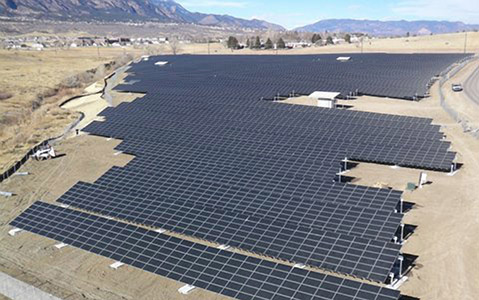It's no secret that property owners can lower the cost of buying and installing solar panels by combining their purchasing power with other solar-inclined shoppers to get what amounts to a group discount.

This photovoltaic array located at the the National Renewable Energy Laboratory in Golden, Colorado is an example of a government facility that went solar to lower operating costs. Several government agencies are working together to cut through the red tape that made projects like this hard to get off the ground. A new streamlined procedure is expected to get clean energy to nine federal sites in Northern California and Nevada within the next two years. DOE/NREL 17749/Patrick Corkery
By Bill Picture
Published: May, 2015
It’s no secret that property owners can lower the cost of buying and installing solar panels by combining their purchasing power with other solar-inclined shoppers to get what amounts to a group discount. Last month, four federal agencies announced they’re partnering for one of these aggregate solar purchases, the first-ever federal group solar buy.
It’s a huge step toward achieving President Obama’s March executive order that requires federal agencies to cut greenhouse gas emissions by forty percent and increase renewable energy use by thirty percent by 2025.
The U.S. Environmental Protection Agency (EPA), U.S. Forest Service (USFS), Department of Energy (DOE) and General Services Administration (GSA) are working together to cut through the red tape that’s made it difficult for federal agencies as a whole to get solar projects off the ground. To that end, they’ve developed a streamlined procurement process that the participating agencies predict will get clean energy to nine federal sites in Northern California and Nevada within the next two years.
“It took two years to write the request for proposal, but it’s now very straightforward,” said Jared Blumenfeld, EPA’s Region Nine Administrator. “Before now, the contracting procedure was so complex that no one really even wanted to tackle it. We solved that, we think; and it’ll be easy for the next folks. That’s very important. If you’re out in, say, Rhode Island and want to do this now, you won’t be starting from square one.”
It’s no coincidence that Blumenfeld’s territory is the guinea pig for the Federal Aggregated Solar Procurement Project (FASPP), as the program has been dubbed. Region Nine is one of the country’s greenest, with a booming solar industry literally sitting on its front doorstep.
“And that’s why we started here,” Blumenfeld said. “With a big project like this, you want to start where you know you have a strong likelihood of success.”
“Solar is very cost-effective in California,” said David McAndrew of DOE’s Federal Energy Management Program, whose role is to provide technical assistance to the participating agencies in evaluating bids. “Plus, solar has a lot of advocates in this area at the federal level, and they really wanted to do something.”
“We’re definitely big cheerleaders for solar,” said Blumenfeld. “Now we step up that role to be cheerleaders for this project.”
Leading the way for government and the private sector
Most of the participating sites have already taken steps to reduce energy consumption on-site. That’s a necessary first step, said Blumenfeld. “As government agencies—and in EPA’s case, an agency dedicated to protecting the environment—it’s important that we lead by example,” he said. “I think that’s the idea behind the President’s executive order.” EPA Region 9 has reduced its energy consumption by 25 percent in recent years.
“Everyone is doing their part,” said DOE’s David McAndrew. “DOE has a long history of reducing energy consumption, going back to the 1985 Energy Policy Act.” McAndrew said that energy use at DOE facilities has been reduced by 26 percent between 2003 and 2013. That’s in addition to a prior 30 percent reduction.
“We want to lead the effort, and we’re always pushing to find ways to better energy efficiency. I think we now compare pretty favorably with efforts being made by the private sector.”
And with hundreds of federal sites dotting the country, the environmental benefits of an across-the-board reduction in energy use coupled with a large-scale group switchover to solar are immeasurable. That’s the long-term goal of the FASPP.
“The hope is to replicate this where it makes the most sense financially,” McAndrew explains. “We probably won’t see every federal facility in the country go solar, not right away at least. It’s just not cost-effective yet in some parts of the country. But we can expect to see similar efforts over the course of the next few months.”
Taxpayer savings are another expected benefit. “By combining the procurement for these nine sites, we anticipate realizing lower utility rates,” said Samuel J. Morris III, GSA’s acting regional administrator, in a written statement announcing the new federal partnership.
“It’s like the Britney Spears song ‘All Eyes on Us,’” joked EPA’s Blumenfeld. “The rest of the federal government is watching to see how this goes.”
Energy-related measures are just one way that federal agencies are cleaning up their collective act. For instance, Blumenfeld says Region 9 offices have reduced water use by 40 percent, an important step given California’s drought conditions. They’re also 90 percent of the way toward achieving zero-waste goals.
“We’ve even gotten rid of all our trash cans. We’re like the U.S. Forest Service, you pack it in and you pack it out,” he said.
The U.S. Forest Service happens to play a very key role in the success of the FASPP. The RFP makes available for the very first time parcels of USFS-governed land to host large-scale solar projects that will power federal sites.
“There are nine total parcels of land on the table,” Blumenfeld explains. “Between GSA and Forest Service lands, we have the capacity to build these larger-scale utilities that then serve a lot of agencies. And there are solar companies out there looking for large plots of land to build solar facilities. So we’re expecting people to bid on the RFP.”
“It is an honor to be involved in this cutting-edge, collaborative project that directly supports the federal sustainability goals of the next decade,” said Randy Moore, regional forester for USFS’s Pacific Southwest Region, in a statement announcing the FASPP.
“It’s not often that federal agencies get to come together and work together, so we’re all very excited about this,” said McAndrew. “The President set a high standard for the federal government and to meet it, collaboration is truly the name of the game here.”

This two-megawatt photovotaic system was installed at the U.S. Army Fort Carson base in Colorado Springs. The system was financed through a power purchase agreement. Photo courtesy US Army Fort Carson

